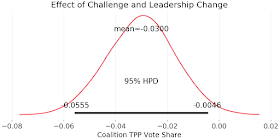The short answer is that on the day, the change cost the Coalition three percentage points in TPP vote share.
In the above run, I did not activate the set-up code which reduces the influence of the noiser polling houses. So three pecentage points is probably conservative.
The model code is as follows ...
// STAN: Two-Party Preferred (TPP) Vote Intention Model
// - Updated to allow for a discontinuity event (Turnbull -> Morrison)
// - Updated to exclude some houses from the sum to zero constraint
// - Updated to reduce the influence of the noisier polling houses
data {
// data size
int<lower=1> n_polls;
int<lower=1> n_days;
int<lower=1> n_houses;
// assumed standard deviation for all polls
real<lower=0> pseudoSampleSigma;
// poll data
vector<lower=0,upper=1>[n_polls] y; // TPP vote share
int<lower=1> house[n_polls];
int<lower=1> day[n_polls];
vector<lower=0> [n_polls] poll_qual_adj; // poll quality adjustment
// period of discontinuity event
int<lower=1,upper=n_days> discontinuity;
int<lower=1,upper=n_days> stability;
// exclude final n houses from the house
// effects sum to zero constraint.
int<lower=0> n_exclude;
}
transformed data {
// fixed day-to-day standard deviation
real sigma = 0.0015;
real sigma_volatile = 0.0045;
int<lower=1> n_include = (n_houses - n_exclude);
}
parameters {
vector[n_days] hidden_vote_share;
vector[n_houses] pHouseEffects;
real disruption;
}
transformed parameters {
vector[n_houses] houseEffect;
houseEffect[1:n_houses] = pHouseEffects[1:n_houses] -
mean(pHouseEffects[1:n_include]);
}
model {
// -- temporal model [this is the hidden state-space model]
hidden_vote_share[1] ~ normal(0.5, 0.15); // PRIOR
disruption ~ normal(0.0, 0.15); // PRIOR
hidden_vote_share[2:(discontinuity-1)] ~
normal(hidden_vote_share[1:(discontinuity-2)], sigma);
hidden_vote_share[discontinuity] ~ normal(hidden_vote_share[discontinuity-1] +
disruption, sigma);
hidden_vote_share[(discontinuity+1):stability] ~
normal(hidden_vote_share[discontinuity:(stability-1)], sigma_volatile);
hidden_vote_share[(stability+1):n_days] ~
normal(hidden_vote_share[stability:(n_days-1)], sigma);
// -- house effects model
pHouseEffects ~ normal(0, 0.08); // PRIOR
// -- observed data / measurement model
y ~ normal(houseEffect[house] + hidden_vote_share[day],
pseudoSampleSigma + poll_qual_adj);
}
